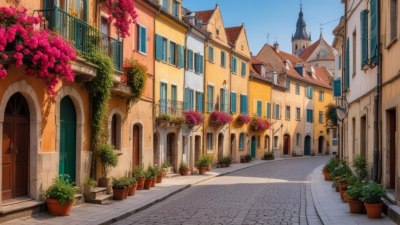Architectural Wonders You Won’t Believe Are Real
Explore stunning architectural marvels around the world that defy belief and showcase human creativity.

Throughout history, architects and builders have pushed the limits of design and engineering, creating structures that defy our imagination. From ancient marvels to cutting-edge modern designs, the world is filled with architectural wonders that are not only beautiful but also innovative. In this article, we will explore some of these incredible structures that you won’t believe are real, taking you on a journey through time and design.
The Great Wall of China
One of the most iconic feats of architecture, the Great Wall of China stretches over 13,000 miles across northern China. Built over centuries, this colossal structure was designed for defense against invasions and showcases the ingenuity of ancient engineering. Its impressive length and durability make it a true wonder of the world.
The Colosseum, Rome
Completed in AD 80, the Colosseum is a monumental amphitheater that once hosted gladiatorial contests, public spectacles, and various entertainment events. This elliptical structure could hold up to 80,000 spectators and features a complex system of vaults and arches that have stood the test of time. The Colosseum remains a testament to the architectural prowess of the ancient Romans.
The Burj Khalifa, Dubai
Currently the tallest building in the world, Burj Khalifa stands at an astonishing 828 meters (2,717 feet). Completed in 2010, this architectural masterpiece boasts a unique design inspired by Islamic architecture, featuring a series of setbacks that create a spiraling silhouette. Its observation decks offer breathtaking views of Dubai and beyond.
The Sydney Opera House, Australia
With its distinctive sail-like roof design, the Sydney Opera House is one of the most recognizable structures in the world. Completed in 1973, this multi-venue performing arts center showcases the creativity of Danish architect Jørn Utzon. The building’s layout and design reflect the natural surroundings, making it a harmonious blend of architecture and landscape.
The Sagrada Familia, Barcelona
Antoni Gaudí's masterpiece, the Sagrada Familia, is an extraordinary basilica under construction since 1882. With its intricate facades and towering spires, this church is a unique blend of Gothic and Art Nouveau styles. The combination of natural forms and colorful stained glass creates a breathtaking interior that captivates visitors.
The Louvre Pyramid, Paris
The Louvre Pyramid, designed by architect I.M. Pei, elegantly contrasts with the historic palace of the Louvre. Completed in 1989, this glass and metal structure serves as the main entrance to the museum and symbolizes the blend of modernity with historical significance. Its geometric form and transparency allow natural light to illuminate the underground lobby.
The Eiffel Tower, Paris
Constructed in 1889 for the Exposition Universelle, the Eiffel Tower stands as a symbol of Paris and French ingenuity. Designed by Gustave Eiffel, this iron lattice tower reaches a height of 300 meters (1,083 feet). Its unique structure and aesthetic appeal attract millions of visitors each year, making it one of the most visited monuments in the world.
Fallingwater, Pennsylvania
Designed by Frank Lloyd Wright, Fallingwater is a stunning example of organic architecture, seamlessly integrating the building with its natural surroundings. Built over a waterfall in 1935, this house features cantilevered terraces that offer spectacular views of the forest and stream below. Fallingwater illustrates the harmony that can be achieved between architecture and nature.
The Tower of Pisa, Italy
The Leaning Tower of Pisa is renowned for its unintended tilt, which has become its defining feature. Completed in the 14th century, this freestanding bell tower was originally built to be perfectly vertical. However, due to unstable foundation soil, it began to lean during construction. Despite this, the tower remains a magnificent example of Romanesque architecture and draws visitors from around the globe.
The Pantheon, Rome
The Pantheon, built around AD 126, is remarkable for its massive dome and oculus, which remain the largest unreinforced concrete dome in the world. This ancient temple was dedicated to the Roman gods and showcases the engineering brilliance of the time. The harmonious proportions and use of light create a serene atmosphere that continues to inspire architects today.
The Shard, London
Standing at 310 meters (1,016 feet), The Shard is the tallest building in the United Kingdom. Completed in 2012, it features a unique façade of glass that reflects the city’s skyline. Designed by architect Renzo Piano, The Shard offers stunning views of London from its observation deck and has quickly become a symbol of modern architecture in the city.
The Guggenheim Museum, Bilbao
The Guggenheim Museum in Bilbao, Spain, is a masterpiece of contemporary architecture designed by Frank Gehry. Completed in 1997, the museum’s innovative design and curvilinear forms have transformed the city into a cultural hotspot. The use of titanium cladding and distinctive shapes create a striking visual effect that complements the surrounding landscape.
St. Basil's Cathedral, Moscow
Known for its colorful onion domes, St. Basil's Cathedral is an iconic symbol of Russia. Completed in 1561, this architectural wonder combines a unique design with spiritual significance. Its vibrant colors and intricate detailing are a feast for the eyes, making it one of the most photographed landmarks in the world.
The Petronas Towers, Kuala Lumpur
The Petronas Towers, once the tallest buildings in the world, stand at 452 meters (1,483 feet) and feature a distinctive design that represents Islamic art. Completed in 1998, these twin towers are connected by a sky bridge, providing spectacular views of the city. The towers have become an iconic symbol of Kuala Lumpur.
Neuschwanstein Castle, Germany
Perched on a hilltop in Bavaria, Neuschwanstein Castle is a fairy-tale structure that inspired Disney’s Cinderella Castle. Built in the 19th century for King Ludwig II, this romantic castle features stunning turrets and picturesque views of the surrounding countryside. Its enchanting design makes it a popular tourist destination and a masterpiece of architecture.
The Baha'i House of Worship, India
The Lotus Temple in Delhi is a Baha'i House of Worship known for its flowerlike design and serene ambiance. Completed in 1986, the temple features 27 marble-clad petals, symbolizing purity and peace. The tranquil surroundings and harmonious architecture create a place for meditation and reflection for visitors of all faiths.
Chichen Itza, Mexico
Chichen Itza is a UNESCO World Heritage site and one of the most significant archaeological sites in Mexico. The iconic El Castillo pyramid showcases the architectural achievements of the Mayan civilization. Built during the 9th century, its precise astronomical alignments are a testament to the advanced knowledge of the Mayans in mathematics and engineering.
The Arc de Triomphe, Paris
The Arc de Triomphe honors those who fought and died during the French Revolutionary and Napoleonic Wars. Commissioned by Napoleon Bonaparte in 1806 and completed in 1836, this monumental arch stands at 50 meters (164 feet) tall. Its intricate sculptures and historical significance make it a must-see landmark in Paris.
Palace of Versailles, France
The Palace of Versailles is famous for its opulent architecture and stunning gardens. Originally a hunting lodge, Louis XIV transformed it into a symbol of absolute monarchy in the 17th century. The palace features grand halls, lavish rooms, and perfectly manicured gardens that exemplify the extravagance of the French monarchy.
One World Trade Center, New York
One World Trade Center, also known as the Freedom Tower, stands as a symbol of resilience and renewal following the events of September 11, 2001. Completed in 2013, this skyscraper rises to a height of 541 meters (1,776 feet), making it the tallest building in the Western Hemisphere. Its design reflects the principles of sustainability and modern architecture.
Casa Batlló, Barcelona
Another masterpiece by Antoni Gaudí, Casa Batlló is known for its whimsical design and colorful façade. Completed in 1906, this building features organic shapes, vibrant mosaics, and intricate details inspired by nature. Casa Batlló is a UNESCO World Heritage site and a prime example of Catalan Modernisme.
The Taj Mahal, India
The Taj Mahal is a white marble mausoleum built in the 17th century by Mughal Emperor Shah Jahan in memory of his wife Mumtaz Mahal. Considered one of the most beautiful buildings in the world, its symmetrical gardens and intricate inlay work exemplify Mughal architecture. The Taj Mahal attracts millions of visitors each year and is a symbol of eternal love.
The Brooklyn Bridge, New York
The Brooklyn Bridge, completed in 1883, was one of the first suspension bridges ever built. Designed by John A. Roebling, this iconic structure connects Brooklyn and Manhattan over the East River. Its Gothic-style towers and intricate cable system make it an engineering marvel and a beloved symbol of New York City.
The Basilica of the National Shrine of the Immaculate Conception, Washington D.C.
As the largest Roman Catholic church in the United States, the Basilica of the National Shrine of the Immaculate Conception is renowned for its stunning architecture and beautiful mosaics. Completed in 2017, this basilica features a blend of Romanesque and Byzantine styles, with exquisite chapels dedicated to various saints, making it a place of worship and pilgrimage.
Around the globe, these architectural wonders captivate our imagination and inspire awe. They remind us of the creativity and innovation that can emerge when we dare to push the boundaries of what is possible. Whether ancient or modern, each structure tells a story of human achievement and reflects the values and culture of its time. As we explore these incredible buildings, we appreciate the artistry and dedication that went into their creation, and we are left in wonder at the possibilities of architecture.











